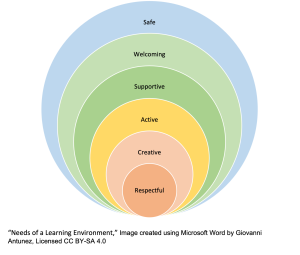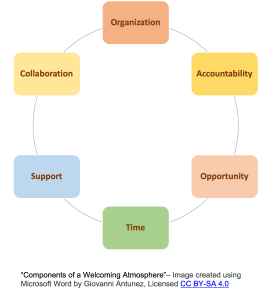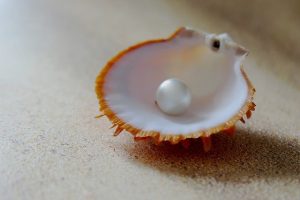4 Facilitating Face to Face or Online / Virtual OER Learning Circle Sharing Circles
Feedback from a Learning Circle Participant:
“Learning Circles are exactly what their titles say. We circle around learning and that is the natural process of learning. As we circle around it, we can make our projects better and better.”
“The most helpful strategy was having regular meetings that acted as check-ups and accountability. Further, as usual in this group, we keep learning new things, tips, and tricks to work on our classes beyond OER- related topics. These extra benefits actually match perfectly with the design of our courses. I have been a better designer of my courses overall after participating in the OER circles.”
Dr. Monica Garcia Perez
Summer 2020
Nurturing a professional academic learning environment
A key aspect to any learning situation is the working environment instructors or facilitators provide for learners. An instructor working as a facilitator is one of the key factors responsible for ensuring learner success. Understanding the needs and the goals of learners is important in ensuring that they meet the goals and objectives that facilitators have created as course objectives, and the goals and or objectives that they as learners (or in the case of OER Learning Circles, professionals developing within their fields of expertise), have created for themselves.
This section highlights the ideal OER Learning Circle Faculty Sharing Circle environment. The facilitator will want the learning environment to be safe, welcoming, supportive, active, creative, and respectful.
 |
To ensure that these elements are the core components of the learning environment, one must define specific parameters in which activities occur; guiding the social interactions and professional practices that take place in the environment.
Feedback from an OER Learning Circle Participant
If you were in the 10am session this week, you witnessed the pep talk I received from Karen. My pearl this week is from Karen, reminding me (and all of us) that we are experts in our fields. She empowered me to go ahead and create and have confidence in what I’m creating – not to feel like I have to find something that is already “out there” for it to be worthy. This was helpful because I felt like while I was trying not to reinvent the wheel, I was ending up spinning my wheels and not making much progress because the materials I found (while all very amazing) did not match my vision. It was a nice reminder that I do have the expertise needed for this work. Thanks, Karen!
Bonnie Robinson
Summer 2023
Components of a Welcoming Atmosphere:
- Organization: Provide a organized structure for success
- Accountability: Hold faculty accountable to self-defined objectives/goals
- Opportunity: Provide an opportunity for creativity, self-expression, academic freedom
- Time: Provide designated time for quality work
- Support: Provide a research-based support structure
- Collaboration: Provide opportunities to collaborate with colleagues across disciplines, as well as to both be mentored and to mentor.See a graphic representation of these concepts:
 |
Creating the Environment
Face to Face Learning Circles
- Secure a room with computer access for anticipated number of participants for ten consecutive weeks.
- Schedule your Learning Circles at a time that you believe most faculty at your institution will be free. (Fridays tend to be good) A two to three hour block of time is important for Face to Face meetings, as this meeting includes participants’ work time. (I always provided lunch or snacks.)
- Create an online (D2L) support course room for work that occurs away from the weekly meetings.
- You as the facilitator will set the tone for your in person “Sharing Circles”.
Online Virtual Learning Circles
- Create an online (D2L) support course room. The course room should includes tools for submitting documents, discussion area, and a content area for providing links, trainings videos, forms and guided ten week pathways for each project; review, redesign, authoring (ancillary and primary resource) and Learning Circle Leaders.
- Schedule your virtual Zoom Learning Circles via a poll such as Doodle Poll. You may have to schedule more than one session per week to accommodate all participants’ schedules. Send invitations to all participants to get the dates on their calendars.
- You as the facilitator will set the tone for your virtual “Sharing Circles”.
Example Agendas:
To help with the organization of the learning circles, the following are examples of agendas for the first, week 2-9 and final or week 10 Learning Circles.
Learning Circle One Agenda (Sharing Circle)
- Introductions: (Introduce yourself as the facilitator and model how you want participants to
introduce themselves; Name, institution, content area, proposed project. - Explain Learning Circle Process:
Weekly meetings are called “Learning Circles”. These are sharing circles of approximately 30 minutes to one hour depending on the number of participants attending that particular session. Participants share a “Pearl” (Aha moment or something significant from their work that week) or perhaps ask for advice from their colleagues. The rest of the scheduled time is devoted to a guest presenter on a specific topic, discussion between colleagues, or in the face to face Learning
Circles, working independently or with colleagues on their OER project.
(For Face to Face I always bring some type of coffee treat! Fruit, granola bars, etc.)
(In virtual Learning Circles you may need to change this structure depending on the size of your group. If you have a large group it will take the entire hour for sharing. When I have a large group I alternate sharing circles and guest presenters. One week we share and the next week I schedule a guest presenter.) - Explain the role of the Learning Circle Facilitator and Librarian(s)
Learning Circle (weeks two – nine) Agenda
- Introductions / Share “Pearl”
Approximately 30 minutes to one hour depending on the number of participants attending that particular session. Participants share “Pearls” or experiences or ask for advice from colleagues, Librarian, Learning Circle facilitator. (In virtual Learning Circles you may need to change this structure depending on the size of your group. If you have a large group it will take the entire hour for sharing. When I have a large group I alternate sharing circles and guest presenters. One week we share and the next week I schedule a guest presenter.) - The rest of the scheduled time is devoted to a guest presenter on a specific topic, discussion between colleagues, or in the face to face Learning Circles, working independently or with colleagues on their OER project. (For Face to Face I always bring some type of coffee treat! Fruit, granola bars, etc.)
Learning Circle Ten / Session Wrap up
The last Learning Circle of the semester is devoted to the session wrap up and providing directions for preparing for a Show Case Event. At the institution level the Show Case Event takes place in this last session. During the last Learning Circle faculty take turns showcasing the end product of their project with their colleagues. At the system level all participants from the past summer, fall, and present spring Learning Circles share their projects with their colleagues from all three semesters and faculty and administrators from across the system. The system level Show Case Event is scheduled annually in April of that current year. Participants from all three semesters share their projects on four scheduled dates, one per week in April.
Institutional Level:
- Introductions / Share “Pearl”

Image of a beach shell pearl “Shell, The beach pearl, Beach image” Image from Pixabay, free use. - Mini Cohort Showcase Event: Share projects ( 2-5 minute lightning talks). Practice for larger system wide event.
System Level:
1. System Wide Showcase Event: April of each academic year.
(4-5 days scheduled in April of each academic year showcasing projects from the previous academic year summer and fall cohorts and the spring cohort from the current academic year.) Participants take turns showcasing their OER work ( Five minute lightning talks with two-four supporting slides) and answering colleagues’ questions. Some log into their course room or work and show highlights and unique features.)
The following is a summary of the content discussed above, or, key takeaways:
Key Takeaways
- The facilitator must create a safe, welcoming, supportive, active, creative, and respectful learning/ working environment.
- The facilitator must define specific parameters in which activities occur; guiding the social interactions and professional practices that take place in the environment.
- The facilitators should be a working instructor (faculty) / Librarian team. This is meant to be a peer / librarian facilitated model.
- The facilitator must understand, respect, and support the needs and the goals of the Learning Circle participants, while still offering guidance.
- The facilitator must ensure that participants meet OER Learning Circle goals and objectives, as well as the goals and objectives that each participant has created for themselves and their OER project.
An instructor working as a facilitator is one of the key factors responsible for ensuring learner success. In this case, the instructor facilitates (or, create the environment) the process instead of directing it.
The acronym OER stands by "Open Educational Resources"
According to the author of this book, The Learning Circle (LC) Model and Process were created to allow participants to be met where they are in the learning process. The author sometimes uses only the words 'model' or 'process' and sometimes both.
D2L = Desire to Learn. It is a common LMS system used to deliver online instruction.
The author uses the words "Sharing Circles" as synonymous of "Learning Circles."
The author uses the word, “Pearl” as a metaphor for an Aha moment, or a Finding or insight
It refers to a setting, occasion, or event for faculty participating in the Learning Circle to present (show case) their work. Commonly faculty uses powerpoint presentations/oral presentations; or, posters' exhibits using mostly an online environment (via Zoom or Teams).
It refers to a setting, occasion, or event for faculty participating in the Learning Circle to present (show case) their work. Commonly faculty uses powerpoint presentations/oral presentations; or, posters' exhibits using mostly an online environment (via Zoom or Teams).
